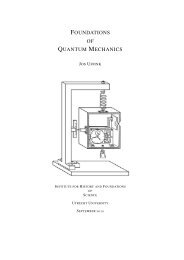Subjective probability and statistical physics
Subjective probability and statistical physics
Subjective probability and statistical physics
You also want an ePaper? Increase the reach of your titles
YUMPU automatically turns print PDFs into web optimized ePapers that Google loves.
the claims (i) that φ is uniform <strong>and</strong> (ii) that the probabilities Pr(E kn ) = 1/(n + 1)<br />
for all n ∈ N.<br />
Given the two ingredients just discussed we can now formulate Bayes’ answer to<br />
the problem he stated. The <strong>probability</strong> that the <strong>probability</strong> P (A) = p of an unknown<br />
event A should lie between a <strong>and</strong> b, given the fact that this event has happened<br />
exactly k times out of n trials is just<br />
Pr(H ab |E kn ) =<br />
(n + 1)!<br />
k!(n − k)!<br />
∫ b<br />
a<br />
p k (1 − p) n−k dp (6)<br />
And from this result, one can also derive the <strong>probability</strong> that event A will happen on<br />
the next, n + 1-th, independent trial, given that it happened k times in the previous<br />
n trials. That calculation, due to Laplace, gives the (in)famous Rule of Succession :<br />
Pr(A n+1 |E kn ) =<br />
(n + 1)!<br />
k!(n − k)!<br />
∫ 1<br />
0<br />
p k+1 (1 − p) n−k dp = k + 1<br />
n + 2<br />
There are several remarks to make about Bayes’ work. First, as already mentioned,<br />
he transformed Bernoulli’s problem into one which is more readily focused on<br />
the question of assessing the <strong>probability</strong> of an unknown event in the light of certain<br />
observed data. And he provided a solution. However, his solution comes at a price:<br />
Bayes needed to attribute probabilities to probabilities.<br />
Secondly, associated with this radical shift in framing the problem there is also a<br />
shift in the role of a priori <strong>and</strong> a posteriori assignments. Recall that for Bernoulli,<br />
these terms represented alternative methods, with the posterior method supposed<br />
to take over where the prior method could not be applied. For Bayes, however,<br />
the posterior <strong>and</strong> the prior are merely consecutive stages in a single method. The<br />
posterior <strong>probability</strong> Pr(H ab |E) is just an update from the initial or prior <strong>probability</strong><br />
assignment we already had antecendently to the arrival of the data, namely Pr(H ab ).<br />
And these probabilities are determined by an appeal to the Principle of Insufficient<br />
Reason. thus, while Bernoulli argued that this principle only has limited validity, <strong>and</strong><br />
that the consideration of empirical data would provide an alternative, Bayes’ solution<br />
to the problem implies that there is, ultimately, no escape from this principle.<br />
As we have seen, in Bayes’ approach it is fundamental that one assigns probabilities<br />
to the values of probabilities. And this was something that Bernoulli, or<br />
other authors before Bayes, had never explicitly contemplated. This brings forth two<br />
further questions. First: Are both probabilities to be interpreted in the same way?<br />
Indeed, are the <strong>probability</strong> P <strong>and</strong> the ”meta”-<strong>probability</strong> Pr both to be interpreted<br />
subjectively? There are two readings that suggest themselves. If the <strong>probability</strong> Pr<br />
represents our beliefs, it seems natural to think that these are beliefs about actual<br />
facts or ‘states of the world’ that may or may not obtain. Hence, since these beliefs<br />
are attributed to hypotheses such as H ab , stating that a ≤ P (A) ≤ b, one would<br />
be inclined to see such hypotheses as having a similar status: they represent some<br />
objective fact unknown to us; something which can only be attributed to the event<br />
A <strong>and</strong> the way it is generated. Thus there would be an objective fact of the matter<br />
what the value of P (A) actually is, even though we do not know it. That suggests<br />
P (A) plays the role of an objective quantity, i.e. an “objective chance”.<br />
On the other h<strong>and</strong>, one could take the view that both <strong>probability</strong> <strong>and</strong> meta<strong>probability</strong><br />
are to be taken subjectively. If so, this leads us to another conundrum: if<br />
8<br />
(7)
















